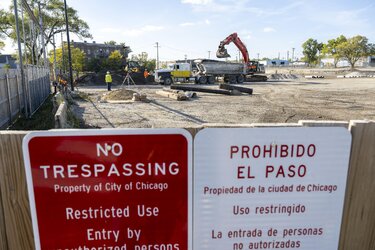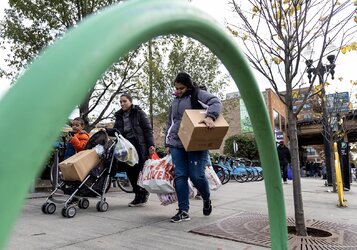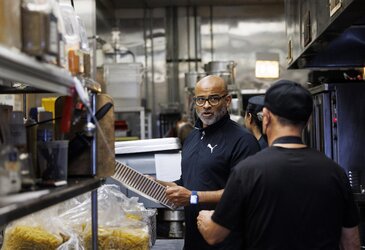Construction of winter tents for migrants in Brighton Park to start Monday
Chicago Sun-Times (
archive.ph)
By David Struett
2023-11-27 02:16:57GMT
 Protesters blocks a city tractor from leaving a city-owned lot at 38th and California this month. The city plans to set up winterized base camps to house up to 1,500 migrants on the land that once housed a zinc smelter. Tyler Pasciak LaRiviere/Sun-Times
Protesters blocks a city tractor from leaving a city-owned lot at 38th and California this month. The city plans to set up winterized base camps to house up to 1,500 migrants on the land that once housed a zinc smelter. Tyler Pasciak LaRiviere/Sun-Times
Crews will begin constructing winter tents meant to house up to 1,500 migrants in Brighton Park on Monday, the local alderperson says.
The city is moving forward with
the camp at 38th Street and California Avenue despite not sharing a study that shows the former industrial site
needs to be cleaned of toxic metals, Ald. Julia Ramirez (12th) said in a letter released Saturday night.
Contractor GardaWorld is expected to begin the final phase of construction Monday, Ramirez said in the letter, while distancing herself from Mayor Brandon Johnson’s choice to continue with the project.
“Let me be clear: I am opposed to the construction of this site, especially as the full environmental impact study results have not been shared with my office or with the community,” Ramirez said in the letter.
On Sunday, the mayor’s office said “the city is confident that the property will be suited for the purpose for which it will be used. Additional details regarding environmental information will be provided this week.”
The property, previously owned by a railroad company, at one point
included a zinc smelter, the Sun-Times has reported. The city said it has cleaned the site of chemicals, but Ramirez said it was not enough to ensure the health of anyone who may live there.
 Construction crews with the Chicago Department of Water Management work on a lot owned by the city at 38th Street and California Avenue. Tyler Pasciak LaRiviere/Sun-Times
Construction crews with the Chicago Department of Water Management work on a lot owned by the city at 38th Street and California Avenue. Tyler Pasciak LaRiviere/Sun-Times
“We have been made aware that toxic metals are present in the soil, and although remediation has been done, after a history of bad communication and lack of transparency from the city, this is not enough to assure the safety and health of the new arrivals expected to live on the site,” the freshman alderperson said.
As temperatures drop and
snow falls, the city is facing pressure to find warm places to shelter thousands of migrants, many of them who fled desperate conditions in Venezuela. More than 1,400 migrants remain camped out at Chicago police stations, according to the city. Another 160 are at O’Hare Airport.
Ramirez has faced heat from her constituents over the plan that she says Johnson’s office hadn’t consulted her about. Construction crews have been preparing the site for weeks as protesters camped outside it.
Residents have protested outside the Southwest Side lot since they learned that it was under consideration to become the first of Johnson’s “winterized base camps.” At one demonstration, protesters
attacked Ramirez and an aide.
Work on
another possible migrant camp site at 115th and Halsted streets also is underway.
Johnson has said he
will begin removing migrants from temporary shelters in January.
Around 25,000 migrants have been
bused or
flown to Chicago, mostly from Texas, since August 2022.
https://cdn.vox-cdn.com/uploads/chorus_asset/file/25113377/Ramirez_38th_Cal_camp_letter.pdf (
archive.org)
---
Half full: Migrants struggle to eat in Chicago
Chicago Tribune (
archive.ph)
By Nell Salzman and Talia Soglin
2023-11-24 11:00:00GMT
 Venezuelan migrant Jessmar, 4, eats an apple after her mother, Jessana Malaue, 27, purchased food at a WIC grocery on West Cermak Road in Chicago on Nov. 10, 2023. Malaue purchased three bags of produce from the WIC grocery due to shelter restrictions that limit migrants from keeping food that can’t fit in a backpack under their cots. (Armando L. Sanchez/Chicago Tribune)
Venezuelan migrant Jessmar, 4, eats an apple after her mother, Jessana Malaue, 27, purchased food at a WIC grocery on West Cermak Road in Chicago on Nov. 10, 2023. Malaue purchased three bags of produce from the WIC grocery due to shelter restrictions that limit migrants from keeping food that can’t fit in a backpack under their cots. (Armando L. Sanchez/Chicago Tribune)
Jessana Malaue spends a lot of time worrying about food.
She worries whether her family members in Venezuela are getting enough to eat in the impoverished country she fled from. She worries about the appetite of her 4-year-old daughter, Jessmar, who has stopped eating the cornflakes, hot dogs and cold chicken offered to her at the chilly, crowded warehouse they live in on the Lower West Side in Pilsen.
And as she watches the shelter employees throw away the perfectly good food that she and other migrants bring into the warehouse, she wonders how she can be surrounded by so little, yet so much, at the same time.
“Están revisando las camas para botar la comida. Me da tristeza ver. They check around our beds to throw away our food. It makes me so sad,” Malaue said.
 Jessana Malaue, 27, and her 4-year-old daughter, Jessmar, ride a bus from their migrant shelter near Pilsen to buy food at a WIC grocery on West Cermak Road on Nov. 10, 2023. (Armando L. Sanchez/Chicago Tribune)
Jessana Malaue, 27, and her 4-year-old daughter, Jessmar, ride a bus from their migrant shelter near Pilsen to buy food at a WIC grocery on West Cermak Road on Nov. 10, 2023. (Armando L. Sanchez/Chicago Tribune)
Thousands of migrants in the city — mostly from Venezuela — come from a country that can’t provide food to its citizens due to decreased food availability, hyperinflation and the fall of local production and imports. But in Chicago, feeding nearly 14,000 food-insecure people daily, in addition to existing populations who rely on food assistance, is no easy task.
Migrants come with few resources and fewer paths to work legally. They rely on state and local money for food assistance at temporary shelters or police stations, and add to the strain on already high-trafficked food pantries. The state
recently earmarked $5 million to the Greater Chicago Food Depository, on top of $5.5 million the organization received earlier in the fall, said spokesperson Jim Conwell.
Conwell said a baseline of food insecurity brought on by the pandemic was made worse by hundreds of migrants arriving daily.
“Even if Chicago wasn’t receiving busloads of people every day, the need would still be really high,” he said.
Migrants say that, unlike in their home country, there’s a lot of food in grocery stores in Chicago, and they’re grateful for the city’s aid. But the food distribution at police stations is uncoordinated, the meals at city shelters are substandard and often not to their liking, and they have to follow strict rules about what outside food they can bring inside.
Some restaurants partnering with the Food Depository try to cater to the tastes and preferences of the migrants, but Malaue — who is grateful for the meals — simply wishes she could cook her own dishes for her daughter: arepas — traditional Venezuelan crispy white corn cakes — and bolitas de queso, or fried balls of corn and cheese.
“We eat meals from big aluminum trays they bring in every day,” she said. “But there are so many mothers inside who want to cook for their children.”
How Chicago responds to hunger
Access to nutritious and varied food options has become almost impossible for millions of Venezuelans, which is part of the reason many migrate to the United States.
A Food Security Assessment conducted by the World Food Program in 2019, authorized by the regime of Venezuelan President Nicolás Maduro, reported that 2.3 million people, or 7.9% of the population, were severely food insecure, and an additional 7 million (24.4%) were moderately food insecure. Food availability has improved slightly since its lowest point in 2019, but it is still insufficient to meet the needs of the population in the South American country.
Luis Martinez, assistant professor at the University of Chicago Harris School of Public Policy, studies authoritarian governments in developing countries with a focus on Latin America. He is a dual U.S.-Venezuelan citizen, and said there is widespread inequality in the South American country due to Maduro’s strict regime.
“It’s a bit ironic that a regime that promotes itself as socialist and promoting equality has in fact driven the country into one of the most unequal situations on earth,” he said. “The migrant crisis is just the symptom of these people being impoverished.”
Since August 2022, the city’s Department of Family and Support Services has spent $15,602,475 to feed migrants through a contract with the vendor Open Kitchens. But with over 22,100 migrants arriving since last year, the city has also leaned on the Food Depository to provide food at over a dozen different shelters around the city. The Food Depository and Chi-CARE, a volunteer-based nonprofit, coordinate with mutual aid groups to supply lunch and dinner for the 14,000 migrants staying at police stations.
Mayor Brandon Johnson’s deputy chief of staff, Cristina Pacione-Zayas, said feeding so many has been difficult.
“Municipal government was never designed to do this work,” she said. “It’s especially challenging when you’re a new administration. You’re literally learning the mechanics of how this government works ... and you’re dealing with real-time crises around the most basic need.”
The city has a request for proposal out for a yearlong contract to provide meals for migrants that would begin in January 2024.
Meanwhile, food pantries say they’ve seen a large increase in people needing services because of the surge in migrants.
 Families recently arrived from Venezuela carry bags of groceries they received from Nourishing Hope's Sheridan Market food pantry in Chicago on Nov. 10, 2023. (Stacey Wescott/Chicago Tribune)
Families recently arrived from Venezuela carry bags of groceries they received from Nourishing Hope's Sheridan Market food pantry in Chicago on Nov. 10, 2023. (Stacey Wescott/Chicago Tribune)
Food pantry and social services organization Nourishing Hope is serving about 25% more people through its food programs — which include pantries as well as an online delivery program — this year compared with last year. In April, Nourishing Hope registered about 360 new households at its busy Sheridan Market in Lakeview alone, said CEO Kellie O’Connell. In October, the pantry added 800 new households.
“In more recent months, the increase in migrants is driving the increase,” O’Connell said.
Migrants come to Nourishing Hope’s pantries from police stations, shelters and their own housing, O’Connell said. The pantry has tried to increase its offerings of ready-to-eat items such as pre-prepared sandwiches and salads to keep up with the needs of migrants who are living without cooking facilities.
The need among migrants can be acute.
A scene she observed at Sheridan Market in October has stuck with her, O’Connell said.
“There was a mom and a couple kids,” she said. “They were just so grateful to get the food, but it was such an urgent need that as soon as we gave them a half-gallon of milk, they were opening it and passing it around the kids.”
Evelyn Figueroa, director of the Pilsen Food Pantry, said the pantry is also seeing increased demand from migrants who come from nearby shelters and police districts, particularly the 1st and 12th districts.
“They’re not getting enough food,” she said. “They may not be getting the right food.”
Sometimes, Figueroa said, food provided at police districts or shelters isn’t palatable to migrants, especially children. Well-intentioned donors sometimes provide meals from Mexican restaurants on the Lower West Side, she said, for instance, but most new arrivals are from Venezuela and aren’t used to spicy foods.
“I remember times where the food was laden in salsa verde,” she said, “and people were like, ‘We just can’t eat this. We’re not used to it, it’s too hot for us, my 2-year-old won’t touch this.’”
 Venzuelan migrant Yorkaris Bello and her 7-month-old daughter, Jormaris, stand next to a car with food they and other families received from Nourishing Hope in Chicago on Nov. 10, 2023. (Stacey Wescott/Chicago Tribune)
Venzuelan migrant Yorkaris Bello and her 7-month-old daughter, Jormaris, stand next to a car with food they and other families received from Nourishing Hope in Chicago on Nov. 10, 2023. (Stacey Wescott/Chicago Tribune)
The pantry and its free clothing program together serve around 700 to 800 people a week, Figueroa said. Some days, she said, about half of those people are migrants. People rely on the food pantry not just for food, but also for immigration help, utilities and housing.
Figueroa said the pantry is a small organization with an annual operating budget of less than $400,000.
“We are keeping up. We have kept up,” she said. “We’re very, very lean, though.”
How social services help
Migrants staying at city-run shelters and police stations are using existing nutrition assistance programs in Chicago to meet their needs.
Malaue is using the federal special supplemental nutrition program for women, infants, and children, known as WIC, to get juice and fruit and vegetables for her 4-year-old daughter. She asked shelter employees if there was a kitchen she could use at the shelter on the Lower West Side, and was denied.
 Rosa Pedroza measures 4-year-old Jessma’s height and weight while her mother, Jessana Malaue, 27, enrolls in the supplemental nutrition program for women, infants and children at Near North Health center on Nov. 1, 2023. (Armando L. Sanchez/Chicago Tribune)
Rosa Pedroza measures 4-year-old Jessma’s height and weight while her mother, Jessana Malaue, 27, enrolls in the supplemental nutrition program for women, infants and children at Near North Health center on Nov. 1, 2023. (Armando L. Sanchez/Chicago Tribune)
A worker at the shelter told her to go to Near North Health in River North for assistance, she said. Sitting in that warmly lit clinic, she broke into sobs thinking about her grandmother’s health in Venezuela. She said she misses her more than anyone.
“
Muchas veces, mi familia me puede decir ‘Yo estoy bien’ por el teléfono. Pero no sabemos cuántas comidas al día están comiendo. My family can tell me frequently that they are OK on the phone. But I don’t know how many times a day they’re eating,” she said.
She lifted her daughter Jessmar up piggyback, remembering how she had carried her to board the train in Mexico.
Since the beginning of September, Near North Health has served 650 families through their Women Infant and Children’s program, according to spokesperson Ryan Yarell.
Yarell said the U.S. Department of Agriculture benefits are “meant to be supplemental to a healthy diet.” They provide milk, beans or peanut butter, eggs, whole grains, juice and cereal. Families also receive a cash benefit for produce.
Benefits for women range from $10 to $18 monthly, depending on how old the children in the family are.
Malue spent a few minutes with a clinic employee who made sure they understood the requirements of the program, and took Jessmar’s weight and height.
But Malaue was uncertain how they would be able to use their supplemental nutrition benefits, because they were only allowed to keep as much food that would fit in a small backpack under their cots. All the rest would be thrown away. Shelter staff told her this was for rat control.
“Shelter residents are allowed to bring in food, but it must be eaten in the cafeteria/common area and there are microwaves available for use,” said Office of Emergency Management spokesperson Mary May in a statement to the Tribune.
A community-based model
Food insecurity experts point to local models as a solution to better meet the needs of asylum-seekers.
The Food Depository does partner with over a dozen minority-owned businesses to meet the high need in the community and reinvest money in surrounding neighborhoods, spokesperson Conwell said, and the city of Chicago intends to move forward with a contract that follows the same model.
 Owner John Meyer talks Mariana Vavalla, 29, a migrant from Venezuela, while working in the kitchen at BJ’s Market in the South Deering neighborhood on Nov. 7, 2023. (Armando L. Sanchez/Chicago Tribune)
Owner John Meyer talks Mariana Vavalla, 29, a migrant from Venezuela, while working in the kitchen at BJ’s Market in the South Deering neighborhood on Nov. 7, 2023. (Armando L. Sanchez/Chicago Tribune)
John Meyer, owner of BJ’s Market in South Deering, is paid by the Food Depository to provide 1,200 to 1,600 lunches a day at three city-run shelters on the South Side. The restaurant receives $7 to $10 for each meal.
Meyer has owned his soul food restaurant since 1992. To help feed asylum-seekers, he changed his meals from mac and cheese, sweet potatoes, cornbread and mixed greens to street corn, black beans and specialty spiced chicken.
He said this type of work is “refreshing” and more feels more like “team-building.” His business struggled during the pandemic, but the mission to feed asylum-seekers helped it, Meyer said. It is now a takeout venue, with a lunch service for migrants. It employs a few workers from Venezuela.
“The work changes our lives. It’s just so gratifying. It’s the best feeling I’ve had in all of the years of being in business,” he said.
Mariana Vavalla, 29, from the northwest state of Falcón, used to work in restaurants in Venezuela and now prepares lunch for thousands of people who — like her — came here from a food-insecure country. She works six to eight hours Monday through Friday, alongside kitchen employees who have worked at BJ’s for over 15 years.
She got here in August and is staying with a friend nearby. She found BJ’s walking around the neighborhood looking for work, she said.
Wearing rubber gloves and a hairnet, Vavalla moved around the industrial kitchen earlier this month — cutting open plastic bags stuffed with cooked penne and stirring a massive tilt kettle of bubbling Bolognese sauce. She loaded up large rectangular aluminum containers with pasta and sifted Parmesan cheese over them. Steam rose and drifted over the long wooden tables.
 Mariana Vavalla, 29, a migrant from Venezuela, center, and Latoya Goodwin work in the kitchen at BJ’s Market in the South Deering neighborhood on Nov. 7, 2023. They spent the morning making spaghetti Bolognese for migrants staying at three shelters on the South Side. (Armando L. Sanchez/Chicago Tribune)
Mariana Vavalla, 29, a migrant from Venezuela, center, and Latoya Goodwin work in the kitchen at BJ’s Market in the South Deering neighborhood on Nov. 7, 2023. They spent the morning making spaghetti Bolognese for migrants staying at three shelters on the South Side. (Armando L. Sanchez/Chicago Tribune)
“We make so many meals a week but this is my favorite,” she said in Spanish, waiting for the red beef sauce to reach the right temperature.
Brandon Meyer, John’s son and the manager at BJ’s, said working with the Venezuelan population has allowed the restaurant to cater its food closer to asylum-seekers’ likes and dislikes.
“They added their input to the menu. It was a tremendous asset,” he said. “They taste everything.”
Hussein Castillo, manager of Garifuna Flava in Chicago Lawn, provides Caribbean and Latin American lunches and weekend dinners at a city-run shelter in Gage Park with over 300 people. He runs the business with his family, who are from Belize.
They came here with very little support back in the 1980s.
“It’s kind of a full circle thing for us to be able to help provide support for migrants who are in the same situation that we’ve been in. It’s something that we’re definitely proud to be doing,” Castillo said.
Malaue and Jessmar
On a recent morning, Malaue left the shelter on the Lower West Side to buy apples with her WIC card. She got on the 21 bus with Jessmar and rode a few stops to South Ashland Avenue and West Cermak Road, where she entered the WIC grocery store — a market offering a limited amount of vegetables, cereal, canned goods and other staples.
Jessmar ran around the aisles picking up pumpkins. She hid behind the shelves of white bread and poked her head out.
“¿Quieres duraznos? Do you want peaches?” Malaue asked her.
Jessmar nodded her head.
“Quiero uvas. I want grapes,” she said.
 Jessana Malaue holds daughter Jessmar as she cries before they near their shelter near Pilsen after buying food at a WIC grocery, Nov. 10, 2023 in Chicago. Jessmar cried and told her mother she didn’t want to go inside. (Armando L. Sanchez/Chicago Tribune)
Jessana Malaue holds daughter Jessmar as she cries before they near their shelter near Pilsen after buying food at a WIC grocery, Nov. 10, 2023 in Chicago. Jessmar cried and told her mother she didn’t want to go inside. (Armando L. Sanchez/Chicago Tribune)
Malaue said there weren’t any grapes in the small store for sale, gently grabbed her little arm and went to the counter to check out. She put three bags of fruit in her backpack, but took an apple out and gave it to Jessmar.
She still hadn’t been eating very much at the shelter, Malaue said.
The mother and daughter were given a pamphlet with a berry crisp recipe in Spanish and a set of red plastic measuring baking cups by WIC grocery employees.
But Malaue said they didn’t have an oven where they were temporarily staying even if they wanted to bake. Malaue wanted to buy broccoli because it was her daughter’s favorite vegetable, but she didn’t have access to a stove.
When they got back to the shelter, Jessmar took one look at the metal warehouse and started crying. She told her mother she didn’t want to go inside.
“Come, sweet one, and I’ll carry you,” she said, resting her on her hip and opening the door to the metal box that was not made for people to sleep in.















